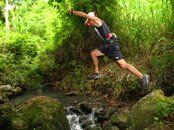Yeah look at all that drag and poor trim...
PS - any given air bubble will be precisely the same size whether it's in a 30lb wing or a 40lb wing. (eg: a liter of air in a 30lb wing is still only a liter of air if it's in a 40lb wing)
Frog kicking is such a slow kick, that drag has far less impact on speed....although drag even for this is going to mean that a big kick, will not provide nearly as long of a big glide, as it would with the much lower drag of no wing at all.
As to bubble size, I see this as sort of like "work expands to the time allowed"....If the diver plans a 40 pound wing, chances are much better that they will end up USING the extra lift of the 40 pound wing, because they "can" support heavier tanks, wetsuits that lose more lift at depth, etc....which will translate into a larger bubble.
If the diver was using a 20 pound wing, they would need to make configuration and gear purchase choices, such as wetsuits with much less buoyancy loss at depth ( this limiting the thickness ) and potentially utilizing newer/better technology like the direction of the Heated Vest by Thermolution under the insulation of the 3 to 5mm wetsuit.
The wetsuit would be more effective, either the type for semi-dry, or ones that use the superior warmth characteristics of Freedive suits with Yamamoto rubber--where a 5 mil freedive suit is often warmer than the 8 mil scuba wetsuits( where the technology pushes the suits ability to have a diver crawl along the bottom on hands and knees like a goat-with great cut and tear resistance), over the need for warmth or optimal movement).
The diver buying the thick low tech wetsuit, will then figure they are fine buying a very heavy HP 100 ( or even heavier HP tank) , so when they get to 120 feet deep, the weight of the tank begins to really exaggerate the loss of lift from the thick suit....and the diver inflates the wing with this MASSIVE bubble to compensate....to compensate for something they should not be compensating for. THIS is the larger bubble I am referring to, from an entire series of wrong choices.
My point in this, is not that most divers should use an 18 pound lift wing like I do ( or no wing at all)....I think the 30 pound lift wing should provide all the lift most divers should need, if they purchase the correct wetsuit and use the correct tanks.
When you get to water too cold for the 3 to 5 mm higher tech wetsuits ( aided by heated vests), then you are in dry suit territory--which still means you can use a 30 pound lift wing.
---------- Post added October 18th, 2015 at 08:12 AM ----------
An example of what "could be" :
Consider a place where a diver might live( or do most of their diving in), where the principal dive sites they enjoy are reefs or wrecks with a known and average bottom depth they will stay close to for most dives.... In such a place ( like Palm Beach, or Catalina in the Kelp (or a hundred other sites) consider a reef line the diver will always be following, with a known depth of say--60 feet deep. It is quite easy for the diver to determine the exact weighting they need with their high tech wetsuit, to be dead neutral at 60 feet, with no wing or bc on....So while in jumping in, they may need to swim downward a bit harder the first 20 feet--like freedivers do....this effort quickly disappears and on reaching their cruising depth, not only is the diver neutral, they are at a much lower drag, which makes their efficiency in propulsion far better, and gas consumption much lower than would occur for their "evil twin" with the traditional scuba setup.
This translates to frog kick where a big kick can create a 10 foot long glide, and actually have the wing-less but neutral diver swimming with frog kick at the speeds of other divers utilizing their flutter kick at full cruising power....or, if the wing-less diver wants to cross over a 400 foot long section of empty sand between 2 reef systems, he can switch to dolphin kick and reach the next reef in 1/3 of the time the traditionally geared divers would require, with 1/3 or less of their gas consumption in this traverse.
Again, I am not suggesting this as any kind of immediate behavior for SB members....If some like this, the first step would be switching to 18 pound wings, and gearing so that when they are a their normal bottom depth, they need ZERO gas added to their BC....and on ascent, and safety stop, so what if they need to keep their feet up over their heads and maintain a steady but easy downward swimming force, to hold 20 feet deep at the stop.....
If they want EXTREME COMFORT on the surface, they can have a snorkel they keep in a storage pouch on the backplate, that they pull out during the safety stop, attach to their mask strap while they are doing nothing during this several minutes...and then they will be perfection on the surface, when they come up. There are many ways of dealing with where to keep a snorkel during a dive. I would much rather deal with the snorkel, than with a BC or wing!







